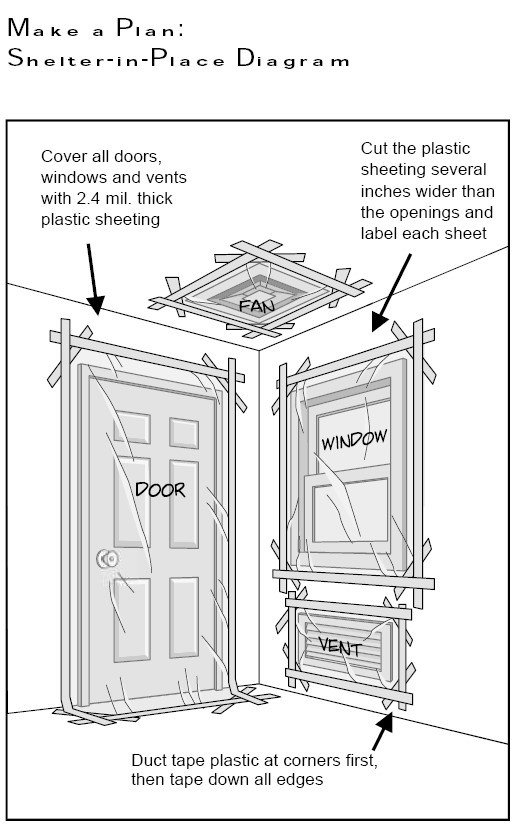Shelter In Place
The aim of this plan is to provide the procedures to be followed in the event of fire, motor vehicle accident, train derailment, industrial incident, or a natural disaster which may cause a hazardous substance release affecting the properties of the Chippewas of Rama First Nation.

As a result, emergency responders may request that you Shelter-In-Place emergencies.
Shelter-In-Place has been demonstrated to be the most effective response during the first few hours of a substance release where the public would be at higher risk outdoors. Sheltering creates an indoor buffer to protect you from higher (more toxic) concentrations that may exist outdoors. It is based on using a building that is not too drafty for typical Canadian winter weather conditions.
The goal of Shelter-In-Place is to reduce the movement of air into and out of the building until either the hazard has passed or other appropriate emergency actions can be taken (such as evacuation). An event such as a fire, motor vehicle accident, train derailment, industrial incident, or a natural disaster may cause a hazardous substance release. As a result, emergency responders may request that you Shelter-In-Place.
Here are some examples of when you may be asked to Shelter-In-Place:
- An outdoor release may affect your building
- There is not enough time or warning to safely evacuate
- The release is expected to pass over the area quickly
- The source and nature of the release has yet to be determined
- A safe evacuation route has yet to be verified
- When it is safe to evacuate but you need assistance
Those who have been advised to Shelter-In-Place will be notified if additional measures are required, and when it is “all-clear”.
When to Shelter-in-Place:
How do you know when to Shelter-in-Place?
The Chippewas of Rama First Nation has a Community Warning System in place that uses several tools to alert the public. The outdoor Emergency Siren located at the Rama Fire Station where it will be sounded. The siren will sound for about 3 minutes, and will be re-sounded periodically during the emergency. Testing of the Siren will be publicly advertised in advance.
Details during a Shelter-in-Place incident are issued by emergency officials via the news media. Be sure you have a battery-powered radio at home and at your place of work.
Shelter-in-Place – At Home:
- Close and lock all windows and exterior doors
- Wet several towels and place them at the base of doors leading to the outside
- If you are told there is danger of explosion, close the window shades, blinds or curtains
- Turn off all fans, heating and air conditioning systems
- Close the fireplace damper
- Prepare to use your family’s emergency survival kit and make sure you have a working battery radio. For more information about assembling an emergency preparedness kit, please contact Rama Fire or check out the Emergency Management Ontario website for guidance
- Go to an interior room without windows. Avoid the basement if possible. Some chemicals are heavier than air and may seep into the basement
- Bring your pets and pet supplies into the interior room
- Try to have a hard-wired telephone in the room you select. Cellular telephone equipment (including portable home phones) may be overwhelmed or damaged during an emergency
- Use duct tape and plastic sheeting (heavier than food wrap) to seal all cracks around the door and any vents into the room. Your emergency survival kit should include two rolls of duct tape, scissors, towels and plastic sheets that have been pre-cut to cover windows, doors and vents
- Stay where you are until you are told it is safe to leave
- Do not attempt to bring your children home from school or daycare. Your children will also be sheltering-in-place at their location
- Remember proper use of the 9-1-1 Emergency Telephone Number. Do not call 9-1-1 to locate relatives or to ask about services during an emergency. Do call 9-1-1 to report a fire, to summon medical assistance or to stop a crime
Shelter-in-Place – At Work
- Close the business or office
- If there are customers, clients, or visitors in the building, provide for their safety by asking them to stay – not leave. When authorities provide directions to shelter-in-place, they want everyone to immediately go indoors at their current location
- Do not attempt to walk or drive home
- Unless there is an imminent threat, ask employees, customers, clients, and visitors to call a family member or friend to let them know where they are and that they are safe
- Turn on call-forwarding or other telephone answering systems or services. If the business has voice mail or an automated attendant, change the recording to indicate that the business is closed, and that staff and visitors are remaining in the building until authorities advise it is safe to leave
- Close and lock all windows, exterior doors, and any other openings to the outside. Wet several towels and place them at the base of doors leading to the outside
- If you are told there is danger of explosion, close the window shades, blinds, or curtains
- Have employees familiar with your building’s mechanical systems turn off all fans, heating and air conditioning systems and air exchanges
- Gather essential disaster supplies, such as nonperishable food, bottled water, battery-powered radios, first aid supplies, flashlights, batteries, duct tape, plastic sheeting, and plastic garbage bags
- Select interior room(s) with the fewest windows or vents. Avoid basements. Some chemicals are heavier than air and may seep into the basement. Avoid rooms with mechanical equipment like ventilation blowers or pipes that cannot be sealed
- Avoid overcrowding if possible. Large storage closets, utility rooms, pantries, copy and conference rooms without exterior windows are good choices
- Use duct tape and plastic sheeting (heavier than food wrap) to seal all cracks around the door(s) and any vents into the room(s)
- Write down the names of everyone in the room, and call your business’s designated emergency contact to report who is in the room with you, and their affiliation with your business (employee, visitor, client, customer)
Shelter-in-Place – In your Car
- Move out of the path of smoke or fumes and attempt to seek shelter indoors. Do not attempt to go through smoke or fumes.
- If you are unable to go indoors, pull over to the side of the road. Stop your vehicle in the safest place possible. If it is warm and sunny, it is preferable to stop under a bridge or in a shady spot.
- Turn off the engine. Close windows and vents.
- If possible, seal the heating/air conditioning vents with duct tape.
- Keep listening to local radio news for information and instructions.
- Stay where you are until you are told it is safe to get back on the road. Be aware that some roads may be closed or detoured. Stay away from the emergency area. Follow the directions of law enforcement officials.
- Do not attempt to bring your children home from school or daycare. Your children will also be sheltering-in-place at their location.
- Remember proper use of the 9-1-1 Emergency Telephone Number. Do not call 9-1-1 to locate relatives or to ask about services during an emergency. Do call 9-1-1 to report a fire, to summon medical assistance or to stop a crime.
Shelter-in-Place – At School
- Close the school. Activate the school’s emergency plan. Follow reverse evacuation procedures to bring students, faculty, and staff indoors
- If there are visitors in the building, provide for their safety by asking them to stay – not leave. When authorities provide directions to shelter-in-place, they want everyone to immediately go indoors at their current location. Do not attempt to walk or drive home
- Provide a hard-wired telephone and sealed shelter for the school secretary or other designated person to answer calls from concerned parents. Establish a method of communication between all rooms. Ideally, the public address system should be accessible for announcements
- If children have cell phones, allow them to call a parent or guardian to let them know that they are safe and remaining at school until given permission to leave. If the school has voice mail or an automated attendant, change the recording to indicate that the school is closed and that students and staff are remaining in the building
- Close and lock all windows, exterior doors, and any other openings to the outside. Wet several towels and place them at the base of doors leading to the outside
- If you are told there is danger of explosion, close window shades, blinds or curtains
- Have employees familiar with your building’s mechanical systems turn off all fans, heating and air conditioning systems and air exchanges
- Gather essential disaster supplies, such as non-perishable food, bottled water, battery-powered radios, first aid supplies, flashlights, batteries, duct tape, plastic sheeting, and plastic garbage bags
- Select interior room(s) with the fewest windows or vents. Avoid basements. Some chemicals are heavier than air and may seep into the basement
- Avoid overcrowding if possible. Classrooms may be used if there are no windows or the windows are sealed and cannot be opened. Large storage closets, utility rooms, meeting rooms, and even a gymnasium without exterior windows, are also good choices
- Use duct tape and plastic sheeting (heavier than food wrap) to seal all cracks around the door(s) and any vents into the room(s)
- Write down the names of everyone in the room and call your school’s designated emergency contact to report who is in the room with you


